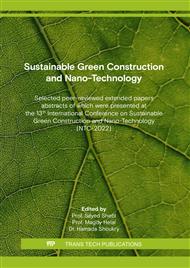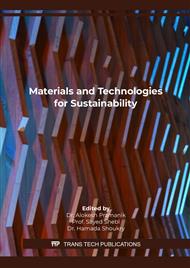p.191
p.207
p.217
p.231
p.239
p.247
p.259
p.271
p.283
Investigation of Tensile Lap-Splice Hybrid Steel Bars Used in RC Beams under Flexure
Abstract:
During the last two decades, fiber reinforced polymer (FRP) reinforcing bars for concrete structure has been extensively investigated and a number of FRP bars are commercially available. Using glass fibers and unsaturated polyester resins, steel fiber reinforced polymer composite bars (SFCB) were manufactured and introduced to the commercial market. Lap splice of such bars must be thoroughly investigated. Limitations of steel reinforcement lengths available from the plant (generally 12 m), causing the construction actors to splice the reinforcement. The simplest and easiest way is to make a lap splice, which made overlap by a certain length is called the developing length of lap splice bar. The main objective of this research using the concept of material hybridization, is to investigate the effect of bar diameter after adding fibers & code equation coefficients for best efficient developing length for tensile lap splice in beams under flexure. Nine RC beams were casted with dimensions of (25*40*420) cms and concrete strength of 300 kg/cm2. Beams were divided into three groups according to the fiber thickness added to 10 mms’ steel bars. First group contained three beams reinforced with hybrid bars of diameter 12 mms, 10mms steel coated with 2mms fiber. Beam one casted using bars with lap splice of 1.3*50φ, beam two casted using bars with lap splice of 1.3*55 φ & beam three casted using bars with lap splice of 1.3*60 φ. Second group contained three beams reinforced with hybrid bars of diameter 14 mms, 10mms steel coated with 4 mms fiber, beam one casted using bars with lap splice of 50φ, beam two casted using bars with lap splice of 55 φ & beam three casted using bars with lap splice of 60 φ. Third group contained three beams reinforced with hybrid bars of diameter 16 mms, 10mms steel coated with 6 mms fiber , beam one casted using bars with lap splice of1.3* 50φ , beam two casted using bars with lap splice of 1.3*55 φ & beam three casted using bars with lap splice of 1.3*60 φ . Beams were tested under four-point load to create a region of pure flexure stress. Load –deflection curves are presented along with percentage differences. Finally, conclusions were drawn and presented in this paper.
Info:
Periodical:
Pages:
283-291
Citation:
Online since:
May 2022
Authors:
Keywords:
Price:
Сopyright:
© 2022 Trans Tech Publications Ltd. All Rights Reserved
Share:
Citation:



